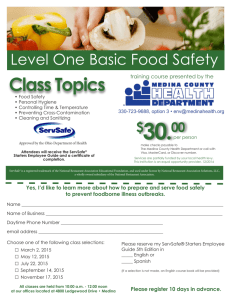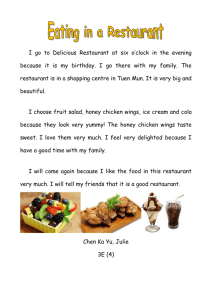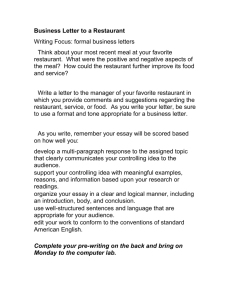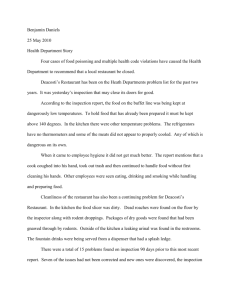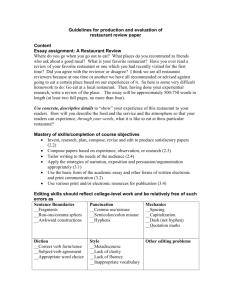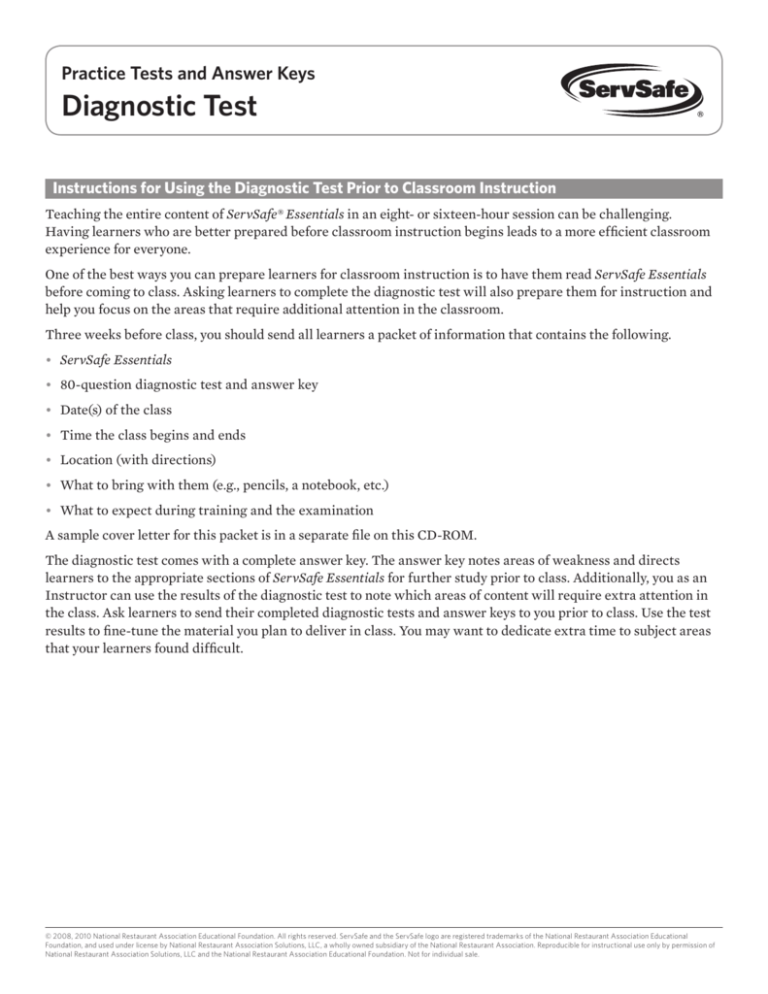
Practice Tests and Answer Keys
Diagnostic Test
Instructions for Using the Diagnostic Test Prior to Classroom Instruction
Teaching the entire content of ServSafe® Essentials in an eight- or sixteen-hour session can be challenging.
Having learners who are better prepared before classroom instruction begins leads to a more efficient classroom
experience for everyone.
One of the best ways you can prepare learners for classroom instruction is to have them read ServSafe Essentials
before coming to class. Asking learners to complete the diagnostic test will also prepare them for instruction and
help you focus on the areas that require additional attention in the classroom.
Three weeks before class, you should send all learners a packet of information that contains the following.
• ServSafe Essentials
• 80-question diagnostic test and answer key
• Date(s) of the class
• Time the class begins and ends
• Location (with directions)
• What to bring with them (e.g., pencils, a notebook, etc.)
• What to expect during training and the examination
A sample cover letter for this packet is in a separate file on this CD-ROM.
The diagnostic test comes with a complete answer key. The answer key notes areas of weakness and directs
learners to the appropriate sections of ServSafe Essentials for further study prior to class. Additionally, you as an
Instructor can use the results of the diagnostic test to note which areas of content will require extra attention in
the class. Ask learners to send their completed diagnostic tests and answer keys to you prior to class. Use the test
results to fine-tune the material you plan to deliver in class. You may want to dedicate extra time to subject areas
that your learners found difficult.
© 2008, 2010 National Restaurant Association Educational Foundation. All rights reserved. ServSafe and the ServSafe logo are registered trademarks of the National Restaurant Association Educational
Foundation, and used under license by National Restaurant Association Solutions, LLC, a wholly owned subsidiary of the National Restaurant Association. Reproducible for instructional use only by permission of
National Restaurant Association Solutions, LLC and the National Restaurant Association Educational Foundation. Not for individual sale.
Practice Tests and Answer Keys
Diagnostic Test Name
Date
Circle the best answer to each question below. Be sure to answer all 80 questions.
1In a heat-sanitizing dishwashing machine, what is the minimum temperature for the final rinse?
A 152˚F (67˚C)
B 180˚F (82˚C)
C 192˚F (89˚C)
D 200˚F (93˚C)
2A foodhandler must be excluded from the operation for which symptom?
A Jaundice
B Coughing
C Cramps
D Sneezing
3The risk of physical contamination can be reduced by
A washing hands before handling food.
B using galvanized containers to store beverages.
C keeping food tightly covered during pesticide applications.
D using shields on fluorescent lightbulbs where food is stored.
4What is the temperature range of the temperature danger zone?
A 0˚F to 212˚F (–18˚C to 100˚C)
B 32˚F to 100˚F (0˚C to 38˚C)
C 41˚F to 135˚F (5˚C to 57˚C)
D 70˚F to 155˚F (21˚C to 68˚C)
5What is a form some bacteria take to keep from dying when they do not have enough food?
A Flagella
B Virus
C Spore
D Parasite
6Most regulations for foodservice operations are written at what level?
A City
B County
C State
D Federal
© 2008, 2010 National Restaurant Association Educational Foundation. All rights reserved. ServSafe and the ServSafe logo are registered trademarks of the National Restaurant Association Educational
Foundation, and used under license by National Restaurant Association Solutions, LLC, a wholly owned subsidiary of the National Restaurant Association. Reproducible for instructional use only by permission of
National Restaurant Association Solutions, LLC and the National Restaurant Association Educational Foundation. Not for individual sale.
Practice Tests and Answer Keys Diagnostic Test
2
7Using one set of cutting boards for raw TCS food and another set of cutting boards for ready-to-eat food reduces the risk of
A cross-contamination.
B time-temperature abuse.
C physical contamination
D toxic-metal poisoning
8What should be used to dry hands after washing them?
A Clean shirt
B Clean apron
C Common cloth towel
D Single-use paper towel
9At what internal temperature should raw meat, poultry, and seafood be stored?
A 41˚F (5˚C) or lower
B 45˚F (7˚C) or lower
C 51˚F (10˚C) or lower
D 55˚F (13˚C) or lower
!0Peanuts and soy products are dangerous for people with what condition?
A FAT TOM
B Food allergies
C Chemical sensitivity
D Poor personal hygiene
!1What type of container should be used to transport TCS food from the place of preparation to the place of service?
A Insulated
B Oversized
C Reflective
D Flexible
!2To learn a new skill, learners must be given the opportunity to
A identify a training need.
B pass an examination.
C go to orientation.
D practice the skill.
!3What is the only jewelry that may be worn on the hands or arms while handling food?
A Plain-band ring
B Medical ID bracelet
C Leather-band watch
D Diamond ring
© 2008, 2010 National Restaurant Association Educational Foundation. All rights reserved. ServSafe and the ServSafe logo are registered trademarks of the National Restaurant Association Educational
Foundation, and used under license by National Restaurant Association Solutions, LLC, a wholly owned subsidiary of the National Restaurant Association. Reproducible for instructional use only by permission of
National Restaurant Association Solutions, LLC and the National Restaurant Association Educational Foundation. Not for individual sale.
Practice Tests and Answer Keys Diagnostic Test
!4Who should apply pesticides in an operation?
A Manager
B Dishwasher
C Pest control operator
D Designated pest employee
!5A backup of raw sewage has occurred in the kitchen. What should happen next?
A Switch to single-use service items.
B Close the affected area and clean it.
C Serve only food prepped before the accident.
D Restrict access to the kitchen to foodhandlers only.
!6When using a bottom-to-top shelving order, what determines the best placement of food in a cooler?
A Size of food package
B Expiration date of food
C Order in which food will be cooked
D Minimum internal cooking temperature of food
!7 A hose connected to a running faucet that is left submerged in a bucket is an example of a(n)
A air gap.
B vacuum breaker.
C cross-connection.
D potable water source.
!8What is the intended use for a hand antiseptic?
A Reduce pathogens on skin
B Minimize the need to wash hands
C Extend the usability of gloves
D Remove unpleasant food odors
!9 An example of TCS food is
A dried apples.
B powdered milk.
C chopped walnuts.
D sliced cantaloupe.
@0 A customer having an allergic reaction may show which symptom?
ACold sweats
B Wheezing
C Dizzy spells
DDehydration
© 2008, 2010 National Restaurant Association Educational Foundation. All rights reserved. ServSafe and the ServSafe logo are registered trademarks of the National Restaurant Association Educational
Foundation, and used under license by National Restaurant Association Solutions, LLC, a wholly owned subsidiary of the National Restaurant Association. Reproducible for instructional use only by permission of
National Restaurant Association Solutions, LLC and the National Restaurant Association Educational Foundation. Not for individual sale.
3
Practice Tests and Answer Keys Diagnostic Test
4
@1Raw or undercooked dishes made for high-risk populations must use eggs that have been
A pasteurized.
B pooled.
C hard-boiled.
D shelled.
@2The effectiveness of chemical sanitizers is NOT affected by its
A concentration.
B contact time.
C color.
D temperature.
@3After forming raw ground beef into patties on the prep line, a foodhandler kept on the same gloves while slicing hamburger
buns. What did the foodhandler do wrong?
A The foodhandler failed to wash hands and change gloves after handling the raw meat.
B The foodhandler failed to wash hands before putting the gloves back on to slice the buns.
C The foodhandler failed to wash and sanitize the gloves before handling the buns.
D The foodhandler failed to rinse the gloves after handling the raw meat.
@4A foodhandler who has just bused tables must do what before handling food?
A Remove apron
B Wash hands
C Put disposable gloves back on
D Wipe hands on a cloth towel
@5Where should pesticides be stored?
A Above workstations in the food-prep area
B In a secure storage area away from food
C On the bottom shelf of the dry-storage area
D In a bin or a box under the sink
@6Which agency enforces food safety in a foodservice operation?
A Centers for Disease Control and Prevention
B Food and Drug Administration
C State or local regulatory authority
D U.S. Department of Agriculture
@7Food in storage should be rotated using which method?
A Periodic order
B FDA rotational
C Last in, first out
D First in, first out
© 2008, 2010 National Restaurant Association Educational Foundation. All rights reserved. ServSafe and the ServSafe logo are registered trademarks of the National Restaurant Association Educational
Foundation, and used under license by National Restaurant Association Solutions, LLC, a wholly owned subsidiary of the National Restaurant Association. Reproducible for instructional use only by permission of
National Restaurant Association Solutions, LLC and the National Restaurant Association Educational Foundation. Not for individual sale.
Practice Tests and Answer Keys Diagnostic Test
@8What can cause histamine to form in tuna?
A Improper curing
B Cross-contamination
C Vacuum packaging
D Time-temperature abuse
@9Several people became ill with Bacillus cereus gastroenteritis after eating time-temperature abused rice. This result is an
example of what?
A Cross-contamination
B Foodborne illness
C Food irradiation
D Stationary phase
#0Why are young children at a higher risk for foodborne illness?
A They are more likely to spend time in a hospital.
B Their immune systems are not yet fully developed.
C They are more likely to suffer allergic reactions.
D Their appetites are suppressed.
#1What is the second basic rule of an integrated pest management program?
A Deny pests food, water, and a nesting or hiding place.
B Prepare a chemical-application schedule.
C Notify the EPA when pesticides will be used.
D Tell the local regulatory authority about all infestations.
#2Food stored in a dry-storage area should NOT be
A touching the walls.
B at least six inches off the floor.
C in moisture-controlled conditions.
D between 50˚F and 70˚F (10˚C and 21˚C).
#3How long must shellstock tags be kept on file?
A 30 days after the day they were received
B 90 days after the day they were received
C 30 days after the container has been emptied or the last shellfish was served from the container
D 90 days after the container has been emptied or the last shellfish was served from the container
#4You should label all ready-to-eat TCS food that is prepped in-house and held longer than
A 12 hours.
B 24 hours.
C 48 hours.
D 72 hours.
© 2008, 2010 National Restaurant Association Educational Foundation. All rights reserved. ServSafe and the ServSafe logo are registered trademarks of the National Restaurant Association Educational
Foundation, and used under license by National Restaurant Association Solutions, LLC, a wholly owned subsidiary of the National Restaurant Association. Reproducible for instructional use only by permission of
National Restaurant Association Solutions, LLC and the National Restaurant Association Educational Foundation. Not for individual sale.
5
Practice Tests and Answer Keys Diagnostic Test
#5What is the definition of sanitizing?
A Rinsing a surface to a clean level
B Using a cloth or brush on a surface until it is clean
C Removing the amount of soil from a surface to safe levels
D Reducing the number of pathogens on a surface to safe levels
#6When transporting food off-site, how should information such as use-by date and time be communicated to the
off-site staff?
A Telephone
B Electronically
C Labels on food
D Verbal instructions
#7What is the first basic rule of an IPM program?
A Keep a PCO out of the facility until an infestation is confirmed.
B Avoid serving customers if an infestation is suspected.
C Try using pesticides before calling a PCO.
D Deny pests access to the facility.
#8The three potential hazards to food are biological, physical, and
A acetyl.
B chemical.
C terminal.
D procedural.
#9People who are “carriers” are able to carry pathogens in their systems and infect others, yet they never
A become ill themselves.
B contaminate food.
C contaminate surfaces
D affect others until symptoms occur.
$0What is the only certain way to prevent backflow?
A Air gap
B Floor drain
C Vacuum-breaker
D Cross-connection
$1When should employees receive food safety training?
A Only when hiring a new employee without foodservice experience
B When hired, and then periodically after that
C.When a new FDA Food Code comes out
D Only when they request it
© 2008, 2010 National Restaurant Association Educational Foundation. All rights reserved. ServSafe and the ServSafe logo are registered trademarks of the National Restaurant Association Educational
Foundation, and used under license by National Restaurant Association Solutions, LLC, a wholly owned subsidiary of the National Restaurant Association. Reproducible for instructional use only by permission of
National Restaurant Association Solutions, LLC and the National Restaurant Association Educational Foundation. Not for individual sale.
6
Practice Tests and Answer Keys Diagnostic Test
$2On-the-job training works best for
A new employees.
B experienced employees.
C individuals or small groups.
D temporary workers.
$3Chili that is being reheated for hot-holding must reach what temperature for 15 seconds within 2 hours?
A 135˚F (57˚C)
B 145˚F (63˚C)
C 155˚F (68˚C)
D 165˚F (74˚C)
$4To work with food, a foodhandler with a hand wound must
A bandage the wound and wear a single-use glove.
B bandage the wound and limit contact with food.
C wash hands and bandage the wound.
D apply ointment and a bandage.
$5How can managers play a key role in promoting good personal hygiene?
A Providing hand lotion in handwashing stations
B Providing comfortable break rooms
C Modeling proper behavior at all times
D Allowing periodic bare-hand contact with food
$6What do time-temperature indicators do?
A Measure temperature through a probe with a sensor at the end
B Measure the length of time that food should be cooked
C Show if food has been cross-contaminated during preparation
D Show if food has been time-temperature abused during shipment
$7What is one way that food should NEVER be thawed?
A In a microwave
B At room temperature
C In a cooler
D As part of the cooking process
$8What is the minimum internal cooking temperature for poultry?
A 135˚F (57˚C)
B 145˚F (63˚C)
C 155˚F (68˚C)
D 165˚F (74˚C)
© 2008, 2010 National Restaurant Association Educational Foundation. All rights reserved. ServSafe and the ServSafe logo are registered trademarks of the National Restaurant Association Educational
Foundation, and used under license by National Restaurant Association Solutions, LLC, a wholly owned subsidiary of the National Restaurant Association. Reproducible for instructional use only by permission of
National Restaurant Association Solutions, LLC and the National Restaurant Association Educational Foundation. Not for individual sale.
7
Practice Tests and Answer Keys Diagnostic Test
$9What is the first step in developing a HACCP plan?
A Identify corrective actions.
B Conduct a hazard analysis.
C Establish monitoring procedures.
D Determine critical control points.
%0Which type of pathogen is hepatitis A?
A Virus
B Bacteria
C Parasite
D Fungi
%1Where is the only place a foodborne virus can reproduce?
A Acidic food
B Person’s intestines
C Food containing protein
D TCS food
%2What is an infrared (laser) thermometer used to measure?
A Air temperature
B Liquid temperature
C Internal temperature
D Surface temperature
%3A training need is a
A measurable knowledge, skill, or ability.
B gap between what an employee knows and what an employee needs to know.
C process used to assess students of varying abilities and experience.
D structured sequence of events that leads to learning.
%4Which is a sign of a possible rodent infestation?
A Strong, oily odor
B Black specks that look like black pepper
C Pile of soft materials in a corner
D Shiny, capsule-shaped egg cases
%5Hot TCS food that has been held below 135˚F (57˚C) for over 4 hours should be
A reheated to 165˚F (74˚C) for 15 seconds.
B thrown out immediately.
C mixed with other hot food.
D eaten within 2 hours.
© 2008, 2010 National Restaurant Association Educational Foundation. All rights reserved. ServSafe and the ServSafe logo are registered trademarks of the National Restaurant Association Educational
Foundation, and used under license by National Restaurant Association Solutions, LLC, a wholly owned subsidiary of the National Restaurant Association. Reproducible for instructional use only by permission of
National Restaurant Association Solutions, LLC and the National Restaurant Association Educational Foundation. Not for individual sale.
8
Practice Tests and Answer Keys Diagnostic Test
%6What is the purpose of Material Safety Data Sheets?
A Inform employees of safe use and hazards associated with chemicals used in the operation
B Provide information on potentially dangerous machinery used in the kitchen
C Monitor the quantity of cleaning materials used on each shift
D To inform customers about the risks of TCS food
%7What is the FDA Food Code?
A The federal government’s recommendations for foodservice sanitation regulations
B A law requiring disclosure of all food additives used in food prepped on-site
C Directory of common food allergens and chemical toxins
D Categorical listings of TCS food
%8A package of flour that arrives on the receiving dock with signs of dampness on the bag should be
A rejected and returned to the supplier.
B accepted and placed in dry storage.
C dried thoroughly before use.
D stored in a cooler at 41˚F (5˚C) or lower.
%9What action should a manager take when a foodhandler reports being diagnosed with shigellosis?
A Keep the foodhandler away from duties that involve food.
B Send the foodhandler home, and then call the local regulatory authority.
C Make sure the foodhandler is supplied with disposable gloves.
D Make sure the foodhandler washes hands often.
^0What happens when the water temperature in a high-temperature dishwashing machine is too high?
A Spray nozzles become clogged.
B Items are sanitized for too long.
C Detergent is left on dishes and utensils.
D The water vaporizes before items can be sanitized.
^1When receiving a delivery of food for an operation, it is important to
A inspect only the TCS food.
B store it immediately and inspect it later.
C inspect all food immediately before storing it.
D stack the delivery neatly and inspect it within 12 hours.
^2To make sure that the chemical sanitizer being used on a food-prep surface is at the correct strength,
A rinse it from the surface and then apply it a second time.
B test the surface first to confirm that there are no pathogens.
C use a test kit to check the sanitizer’s concentration when mixing it.
D heat it to the temperature recommended by the manufacturer.
© 2008, 2010 National Restaurant Association Educational Foundation. All rights reserved. ServSafe and the ServSafe logo are registered trademarks of the National Restaurant Association Educational
Foundation, and used under license by National Restaurant Association Solutions, LLC, a wholly owned subsidiary of the National Restaurant Association. Reproducible for instructional use only by permission of
National Restaurant Association Solutions, LLC and the National Restaurant Association Educational Foundation. Not for individual sale.
9
Practice Tests and Answer Keys Diagnostic Test
10
^3Cold TCS food must be received at what internal temperature?
A 32˚F (0˚C) or lower
B 41˚F (5˚C) or lower
C 50˚F (10˚C) or lower
D 55˚F (13˚C) or lower
^4What is the minimum internal cooking temperature for TCS food cooked in a microwave?
A 135˚F (57˚C)
B 145˚F (63˚C)
C 155˚F (68˚C)
D 165˚F (74˚C)
^5What is the calibration nut on a bimetallic stemmed thermometer used for?
A Keep it accurate
B Mark its sensing area
C Measure air temperature
D Measure temperatures through glass
^6A foodhandler put labeled, ready-to-eat food under raw hamburger patties in the cooler. What was done wrong?
A The foodhandler labeled ready-to-eat food.
B The foodhandler did not use the FIFO method.
C The foodhandler did not place the patties at eye level.
D The foodhandler did not store ready-to-eat food above raw food.
^7If a food-contact surface has been soiled, what four actions must be performed before it can be used again?
A Wiped, rinsed, stored, air-dried
B Cleaned, rinsed, scrubbed, air-dried
C Cleaned, rinsed, sanitized, air-dried
D Degreased, scrubbed, rinsed, air-dried
^8What is the maximum acceptable receiving temperature for fresh poultry?
A 35˚F (2˚C)
B 41˚F (5˚C)
C 45˚F (7˚C)
D 50˚F (10˚C)
^9Labels on containers of ready-to-eat TCS food that was prepped on-site must include the
A ingredients.
B potential allergens.
C reheating instructions.
D date that the food should be sold.
© 2008, 2010 National Restaurant Association Educational Foundation. All rights reserved. ServSafe and the ServSafe logo are registered trademarks of the National Restaurant Association Educational
Foundation, and used under license by National Restaurant Association Solutions, LLC, a wholly owned subsidiary of the National Restaurant Association. Reproducible for instructional use only by permission of
National Restaurant Association Solutions, LLC and the National Restaurant Association Educational Foundation. Not for individual sale.
Practice Tests and Answer Keys Diagnostic Test
11
&0How should a prep table be cleaned and sanitized?
A Spray with a cleaning solution, and then wipe with a sanitized cloth.
B Spray with a sanitizing solution, rinse with clean water, and then dry.
C Brush off loose dirt with a clean cloth, and then wipe or spray with a sanitizing solution.
D Clean and rinse the surface, sanitize the surface, and then air-dry.
&1If a food-contact surface is in constant use, how often must it be cleaned and sanitized?
A Every 4 hours
B Every 6 hours
C Every 8 hours
D Every 10 hours
&2What is the right way to measure the temperature of fresh meat, poultry, or seafood when it is delivered?
A Use the ice-point method.
B Use an infrared thermometer on the container.
C Place a probe on the surface of the food and wait 15 seconds.
D Insert the thermometer stem or probe into the thickest part of the product.
&3What is one factor that affects the growth of microorganisms in food?
A Leanness
B Density
C Ripeness
D Acidity
&4What is the correct procedure for washing hands?
A Wet hands and arms with water at least 41˚F (5˚C). Apply soap. Vigorously scrub hands and arms. Apply a hand antiseptic.
Dry hands.
B Wet hands and arms with water at least 41˚F (5˚C). Apply soap. Vigorously scrub hands and arms. Rinse hands and arms.
Dry hands and arms.
C Wet hands and arms with water at least 100˚F (38˚C). Apply soap. Vigorously scrub hands and arms for 10 to 15 seconds.
Rinse hands and arms. Dry hands and arms.
D Wet hands and arms with water at least 100˚F (38˚C). Apply soap. Vigorously scrub hands and arms. Apply a hand
antiseptic. Dry hands and arms.
&5How should foodhandlers keep their fingernails?
A Short and unpolished
B Long and unpolished
C Long and painted with nail polish
D Short and painted with nail polish
© 2008, 2010 National Restaurant Association Educational Foundation. All rights reserved. ServSafe and the ServSafe logo are registered trademarks of the National Restaurant Association Educational
Foundation, and used under license by National Restaurant Association Solutions, LLC, a wholly owned subsidiary of the National Restaurant Association. Reproducible for instructional use only by permission of
National Restaurant Association Solutions, LLC and the National Restaurant Association Educational Foundation. Not for individual sale.
Practice Tests and Answer Keys Diagnostic Test
12
&6A foodhandler who spends an entire shift deboning chicken should change gloves
A after 1 hour, because the gloves may attract build-up of pathogens quickly.
B every 4 hours during continual use, and more often as needed
C at the end of the shift, when working on a single task
D every 6 hours, to avoid wasting gloves
&7What is the key to limiting bacterial growth?
A Controlling time and temperature
B Evaluating the menu selection
C Managing personal hygiene
D Using food additives
&8When taking the orders of customers with food allergies, a server should
A fully describe each menu item to customers who ask, including any “secret” ingredients.
B fully describe the symptoms of an allergic reaction to customers before they order.
C tell customers when they arrive that the food may cause allergic reactions.
D tell customers with food allergies that they will not be able to receive service.
&9Why should food NOT be stored in a galvanized container?
A The food will spoil quickly.
B The food will not be stored at the right temperature.
C Acids in the food can leach zinc into the food.
D Acids in the food can cause the container to rust.
*0Food should be cooled from 135˚F to 70˚F (57˚C to 21˚C) within
lower within
hours.
hours, and then from 70˚F to 41˚F (21˚C to 5˚C) or
A 2, 4
B 3, 4
C 3, 6
D 4, 2
© 2008, 2010 National Restaurant Association Educational Foundation. All rights reserved. ServSafe and the ServSafe logo are registered trademarks of the National Restaurant Association Educational
Foundation, and used under license by National Restaurant Association Solutions, LLC, a wholly owned subsidiary of the National Restaurant Association. Reproducible for instructional use only by permission of
National Restaurant Association Solutions, LLC and the National Restaurant Association Educational Foundation. Not for individual sale.
Practice Tests and Answer Keys
Diagnostic Test Answer Key
Name
Date
For every question you miss, fill in the box in the “Mark if incorrect” column. The information to the right of this box will tell you
where to turn in your book for additional information on the questions you missed.
Question
Answer
1
Mark if
incorrect
Heading
Essentials
page number
B
High Temperature Machines
11.7
2
A
Policies for Reporting Health Issues
4.12
3
D
Lighting
10.10
4
C
What Pathogens Need to Grow
2.3
5
C
Characteristics of Bacteria That Cause Foodborne Illness
2.11
6
C
State and Local Regulations
13.3
7
A
Cross-Contamination
5.3
8
D
How to Wash Hands
4.5
9
A
Temperatures
6.9
!0
B
Common Food Allergens
3.7
!1
A
Off-Site Service
8.8
!2
D
Classroom Training
14.5
!3
A
Work Attire
4.10
!4
C
Using Pesticides
12.7
!5
B
Sewer
10.10
!6
D
Preventing Cross-Contamination
6.11
!7
C
Cross-Connection
10.9
!8
A
Hand Antiseptics
4.6
!9
D
Food Most Likely to Become Unsafe
2.4
@0
B
Allergy Symptoms
3.6
@1
A
Eggs and Egg Mixtures
7.4
@2
C
Sanitizer Effectiveness
11.5
@3
A
When to Change Gloves
4.9
@4
B
When to Wash Hands
4.6
@5
B
Storing Pesticides
12.8
© 2008, 2010 National Restaurant Association Educational Foundation. All rights reserved. ServSafe and the ServSafe logo are registered trademarks of the National Restaurant Association Educational
Foundation, and used under license by National Restaurant Association Solutions, LLC, a wholly owned subsidiary of the National Restaurant Association. Reproducible for instructional use only by permission of
National Restaurant Association Solutions, LLC and the National Restaurant Association Educational Foundation. Not for individual sale. .
Practice Tests and Answer Keys Diagnostic Test Answer Key
Question
Answer
@6
Mark if
incorrect
2
Heading
Essentials
page number
C
State and Local Regulations
13.3
@7
D
Rotation
6.8
@8
D
Scombroid Poisoning
2.27
@9
B
Challenges to Food Safety
1.2
#0
B
Populations at High Risk for Foodborne Illnesses
1.4
#1
A
Rules of an IPM Program
12.2
#2
A
Dry Storage
6.11
#3
D
Shellfish
6.5
#4
B
Labeling
6.8
#5
D
How and When to Clean and Sanitize
11.2
#6
C
Off-Site Service
8.8
#7
D
Rules of an IPM Program
12.2
#8
B
Potential Hazards to Food Safety
1.5
#9
A
Situations That Can Lead to Contaminating Food
4.2
$0
A
Backflow prevention
10.9
$1
B
Food Safety Training for Staff
14.2
$2
C
On-the-Job Training
14.5
$3
D
Reheating Food
7.16
$4
A
Hand Care
4.7
$5
C
Managing a Personal Hygiene Program
4.4
$6
D
Other Temperature Recording Devices
5.8
$7
B
Thawing
7.2
$8
D
Cooking Requirements for Specific Food
7.9
$9
B
Principle 1: Conduct a Hazard Analysis
9.6
%0
A
Hepatitis A
2.9
%1
B
General Information about Viruses
2.6
%2
D
Infrared (Laser) Thermometers
5.8
%3
B
Training Staff
14.2
%4
C
Rodents
12.7
%5
B
Guidelines for Holding Food
8.2
© 2008, 2010 National Restaurant Association Educational Foundation. All rights reserved. ServSafe and the ServSafe logo are registered trademarks of the National Restaurant Association Educational
Foundation, and used under license by National Restaurant Association Solutions, LLC, a wholly owned subsidiary of the National Restaurant Association. Reproducible for instructional use only by permission of
National Restaurant Association Solutions, LLC and the National Restaurant Association Educational Foundation. Not for individual sale.
Practice Tests and Answer Keys Diagnostic Test Answer Key
Question
Answer
%6
Mark if
incorrect
3
Heading
Essentials
page number
A
Material Safety Data Sheets
11.14
%7
A
The FDA Food Code
13.2
%8
A
Packaging
6.4
%9
B
Policies for Reporting Health Issues
4.12
^0
D
High-Temperature Machines
11.7
^1
C
Receiving and Inspecting
6.3
^2
C
Sanitizer Effectiveness
11.5
^3
B
Cold Food
6.4
^4
D
Cooking TCS Food in the Microwave
7.10
^5
A
Bimetallic Stemmed Thermometer
5.6
^6
D
Preventing Cross-Contamination
6.11
^7
C
How and When to Clean and Sanitize
11.2
^8
B
Cold Food
6.4
^9
D
Labeling
6.8
&0
D
How and When to Clean and Sanitize
11.2
&1
A
When to clean and sanitize
11.3
&2
D
Checking the Temperature of Various Types of Food
6.3
&3
D
What Pathogens Need to Grow
2.3
&4
C
How to Wash Hands
4.5
&5
A
Hand Care
4.7
&6
B
When to Change Gloves
4.9
&7
A
Controlling the Growth of Pathogens
2.5
&8
A
Service Staff
3.8
&9
C
Toxic Metals
3.2
*0
A
Cooling Food
7.14
Continued on the next page œ
© 2008, 2010 National Restaurant Association Educational Foundation. All rights reserved. ServSafe and the ServSafe logo are registered trademarks of the National Restaurant Association Educational
Foundation, and used under license by National Restaurant Association Solutions, LLC, a wholly owned subsidiary of the National Restaurant Association. Reproducible for instructional use only by permission of
National Restaurant Association Solutions, LLC and the National Restaurant Association Educational Foundation. Not for individual sale.
Practice Tests and Answer Keys Diagnostic Test Answer Key
4
Mark the question numbers you missed.
If you missed
Then review
@9 #0 #8
Chapter 1
4 5 !9 @8 %0 %1 &3 &7
Chapter 2 The Microworld
!0 @0 &8 &9
Chapter 3 Contamination and Food Allergens
2 8 !3 !8 @3 @4 #9 $4 $5 %9 &4 &5 &6
Chapter 4 The Safe Foodhandler
7 $6 %2 ^5
Chapter 5 The Flow of Food: An Introduction
9 !6 @7 #2 #3 #4 %8 ^1 ^3 ^6 ^8 ^9 &2
Chapter 6 The Flow of Food: Purchasing, Receiving, and Storage
@1 $3 $7 $8 ^4 *0
Chapter 7 The Flow of Food: Preparation
!1 #6 %5
Chapter 8 The Flow of Food: Service
$9
Chapter 9 Food Safety Management Systems
3 !5 !7 $0
Chapter 10 Sanitary Facilities and Equipment
1 @2 #5 %6 ^0 ^2 ^7 &0 &1
Chapter 11 Cleaning and Sanitizing
!4 @5 #1 #7 %4
Chapter 12 Integrated Pest Management
6 @6 %7
Chapter 13 Food Safety Regulations and Standards
!2 $1 $2 %3
Chapter 14 Employee Food Safety Training
Providing Safe Food
© 2008, 2010 National Restaurant Association Educational Foundation. All rights reserved. ServSafe and the ServSafe logo are registered trademarks of the National Restaurant Association Educational
Foundation, and used under license by National Restaurant Association Solutions, LLC, a wholly owned subsidiary of the National Restaurant Association. Reproducible for instructional use only by permission of
National Restaurant Association Solutions, LLC and the National Restaurant Association Educational Foundation. Not for individual sale.

